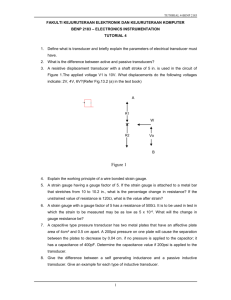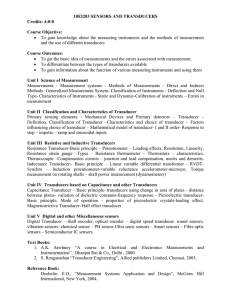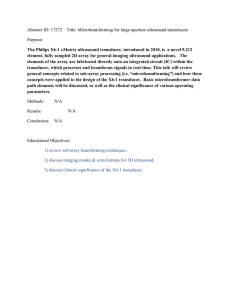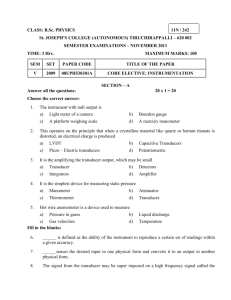Introduction to Pressure Transducers
advertisement
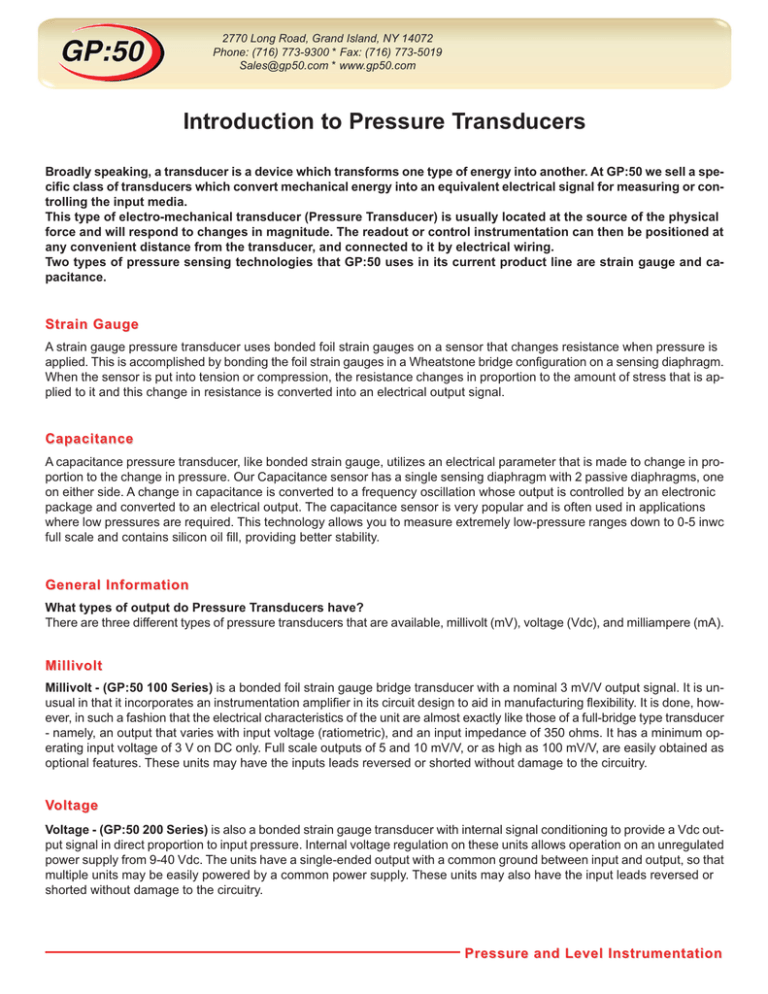
2770 Long Road, Grand Island, NY 14072 Phone: (716) 773-9300 * Fax: (716) 773-5019 Sales@gp50.com * www.gp50.com Introduction to Pressure Transducers Broadly speaking, a transducer is a device which transforms one type of energy into another. At GP:50 we sell a specific class of transducers which convert mechanical energy into an equivalent electrical signal for measuring or controlling the input media. This type of electro-mechanical transducer (Pressure Transducer) is usually located at the source of the physical force and will respond to changes in magnitude. The readout or control instrumentation can then be positioned at any convenient distance from the transducer, and connected to it by electrical wiring. Two types of pressure sensing technologies that GP:50 uses in its current product line are strain gauge and capacitance. Strain Gauge A strain gauge pressure transducer uses bonded foil strain gauges on a sensor that changes resistance when pressure is applied. This is accomplished by bonding the foil strain gauges in a Wheatstone bridge configuration on a sensing diaphragm. When the sensor is put into tension or compression, the resistance changes in proportion to the amount of stress that is applied to it and this change in resistance is converted into an electrical output signal. Capacitance A capacitance pressure transducer, like bonded strain gauge, utilizes an electrical parameter that is made to change in proportion to the change in pressure. Our Capacitance sensor has a single sensing diaphragm with 2 passive diaphragms, one on either side. A change in capacitance is converted to a frequency oscillation whose output is controlled by an electronic package and converted to an electrical output. The capacitance sensor is very popular and is often used in applications where low pressures are required. This technology allows you to measure extremely low-pressure ranges down to 0-5 inwc full scale and contains silicon oil fill, providing better stability. General Information What types of output do Pressure Transducers have? There are three different types of pressure transducers that are available, millivolt (mV), voltage (Vdc), and milliampere (mA). Millivolt Millivolt - (GP:50 100 Series) is a bonded foil strain gauge bridge transducer with a nominal 3 mV/V output signal. It is unusual in that it incorporates an instrumentation amplifier in its circuit design to aid in manufacturing flexibility. It is done, however, in such a fashion that the electrical characteristics of the unit are almost exactly like those of a full-bridge type transducer - namely, an output that varies with input voltage (ratiometric), and an input impedance of 350 ohms. It has a minimum operating input voltage of 3 V on DC only. Full scale outputs of 5 and 10 mV/V, or as high as 100 mV/V, are easily obtained as optional features. These units may have the inputs leads reversed or shorted without damage to the circuitry. Voltage Voltage - (GP:50 200 Series) is also a bonded strain gauge transducer with internal signal conditioning to provide a Vdc output signal in direct proportion to input pressure. Internal voltage regulation on these units allows operation on an unregulated power supply from 9-40 Vdc. The units have a single-ended output with a common ground between input and output, so that multiple units may be easily powered by a common power supply. These units may also have the input leads reversed or shorted without damage to the circuitry. Pressure and Level Instrumentation 2770 Long Road, Grand Island, NY 14072 Phone: (716) 773-9300 * Fax: (716) 773-5019 Sales@gp50.com * www.gp50.com Introduction to Pressure Transducers Milliamp Milliamp - (GP:50 300 Series) termed a transmitter by the industry, is a strain gage device with internal signal conditioning to provide an industry standard 4-20 mA full-scale output signal in direct proportion to the input pressure. These are true, two wire devices, reverse-wire protected, that operate on a 9-40 Vdc excitation and can drive 1200 ohms maximum at 37 Vdc or 600 ohms at 24 Vdc. Selecting a Transducer What are some important factors that must be considered when selecting a Pressure Transducer? There are three primary considerations when selecting a transducer. They are: • System Pressure Requirements 1) The Pressure Requirements of the system Many hydraulic and pneumatic systems exhibit short duration pulses or shocks that are superimposed on a steady state operating pressure. These are caused by a rapid change in system equilibrium due to compressors, pumps, pistons, and valves. Dynamic overpressures have the potential of exceeding the overload capability of the pressure transducer. Opening and closing valves slowly, installing surge tanks, utilizing pressure snubbers or relocating the transducer can prevent damage. To provide maximum protection against dynamic overpressure, GP:50 subjects every transducer to a 200% pressure overload during the manufacture of each transducer. The normal working pressure of the system should be below the maximum range of the pressure transducer. The proof pressure and burst pressure ratings should be sufficiently high to provide an adequate safety margin in the event that there is a system malfunction and an overpressure occurs. As a guideline, a pressure transducer's pressure range should be chosen to be 125% the normal working pressure. • Process Temperature 2) Process Temperature Measurement errors can be introduced due to temperature changes in either the pressure media or in ambient conditions. The temperature range should be within the compensated temperature range of the transducer, and the maximum system temperature should not exceed the maximum stated temperature rating of the pressure transducer. • Compatability 3) Compatability of Pressure Media with the Transducer Measurement Transducers are exposed to a variety of liquids, gases, and slurries. In some applications the pressure media is corrosive, which can damage the sensing diaphragm. This corrosion of the diaphragm will change the transducer's sensitivity as well as its strength, reducing the overpressure capability. The pressure media must be compatible with the components of the pressure transducer, otherwise the lifetime of the pressure transducer is compromised. For further information, please contact the factory direct. Pressure and Level Instrumentation


